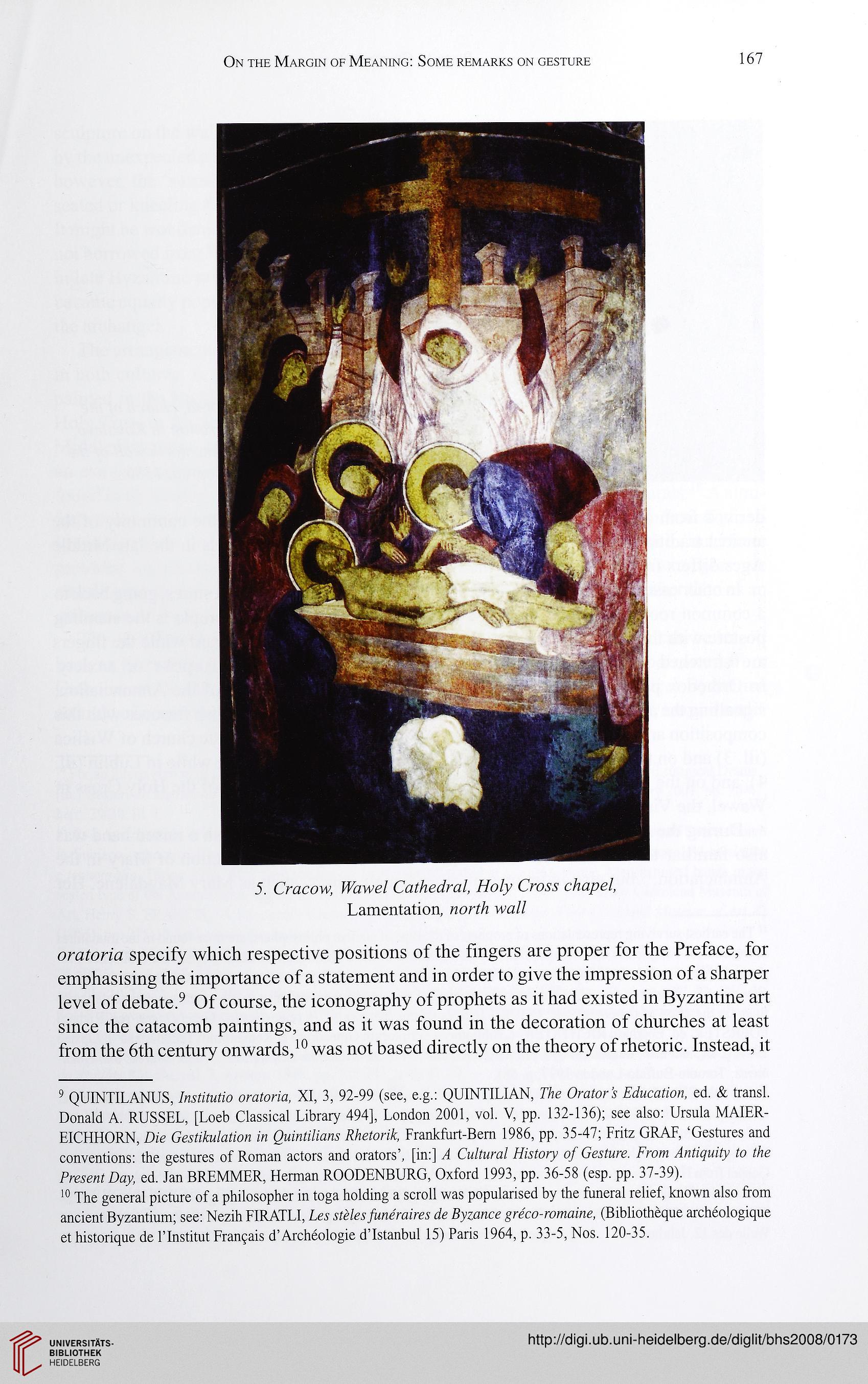ON THE MARGIN OF MEANING! SOME REMARKS ON GESTURE
167
J. Cracow, Jfhwo/ CafAcJan/, 7/o/y Cro.sN cAc/?c/,
Lamentation, ttorfA wa//
ora^ona specify which respective positions of the fingers are proper for the Preface, for
emphasising the importance of a statement and in order to give the impression of a sharper
level of debated Of course, the iconography of prophets as it had existed in Byzantine art
since the catacomb paintings, and as it was found in the decoration of churches at least
from the 6th century onwards,was not based directly on the theory of rhetoric. Instead, it
9 QUINT1LANUS, /astitatio oratoria, XI, 3, 92-99 (see, e.g.: QUINTILIAN, Die Orators D&eatioa, ed. & transi.
Donald A. RUSSEL, [Loeb Classical Library 494], London 2001, vol. V, pp. 132-136); see also: Ursula MAIER-
EICHHORN, Dio GastiAaiatio/i in Qaiatiiiaas P/ietorA, Erankfurt-Bem 1986, pp. 35-47; Eritz GRAF, 'Gestures and
conventions: the gestures of Roman actors and orators', [in:] .4 Ca/tarai Distory of Goytaro. From Hnti^aity to t/ie
Present Day ed. Jan BREMMER, Herman ROODENBURG, Oxford 1993, pp. 36-58 (esp. pp. 37-39).
The general picture of a philosopher in toga hotding a scroll was popularised by the funeral relief, known aiso from
ancient Byzantium; see: Nezih FIRATLI, Tes stèiesfaaeraires & Fyzaace greco-romaine, (Bibliothèque archéologique
et historique de l'Institut Français d'Archéologie d'Istanbul 15) Paris 1964, p. 33-5, Nos. 120-35.
167
J. Cracow, Jfhwo/ CafAcJan/, 7/o/y Cro.sN cAc/?c/,
Lamentation, ttorfA wa//
ora^ona specify which respective positions of the fingers are proper for the Preface, for
emphasising the importance of a statement and in order to give the impression of a sharper
level of debated Of course, the iconography of prophets as it had existed in Byzantine art
since the catacomb paintings, and as it was found in the decoration of churches at least
from the 6th century onwards,was not based directly on the theory of rhetoric. Instead, it
9 QUINT1LANUS, /astitatio oratoria, XI, 3, 92-99 (see, e.g.: QUINTILIAN, Die Orators D&eatioa, ed. & transi.
Donald A. RUSSEL, [Loeb Classical Library 494], London 2001, vol. V, pp. 132-136); see also: Ursula MAIER-
EICHHORN, Dio GastiAaiatio/i in Qaiatiiiaas P/ietorA, Erankfurt-Bem 1986, pp. 35-47; Eritz GRAF, 'Gestures and
conventions: the gestures of Roman actors and orators', [in:] .4 Ca/tarai Distory of Goytaro. From Hnti^aity to t/ie
Present Day ed. Jan BREMMER, Herman ROODENBURG, Oxford 1993, pp. 36-58 (esp. pp. 37-39).
The general picture of a philosopher in toga hotding a scroll was popularised by the funeral relief, known aiso from
ancient Byzantium; see: Nezih FIRATLI, Tes stèiesfaaeraires & Fyzaace greco-romaine, (Bibliothèque archéologique
et historique de l'Institut Français d'Archéologie d'Istanbul 15) Paris 1964, p. 33-5, Nos. 120-35.




